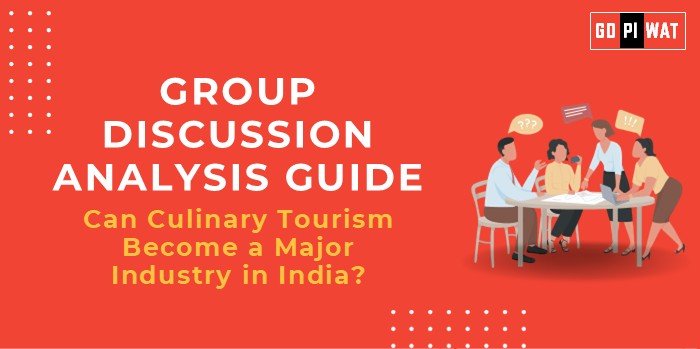📋 Group Discussion (GD) Analysis Guide: Can Culinary Tourism Become a Major Industry in India?
🌐 Introduction to Culinary Tourism
- 💡 Opening Context: Culinary tourism, which involves travel to explore unique food and beverage experiences, has become a global trend. For India, with its rich gastronomic heritage and diverse culinary landscape, it presents an immense opportunity to emerge as a global hub for food enthusiasts.
- 📜 Topic Background: Culinary tourism has gained traction worldwide as travelers increasingly seek authentic cultural experiences through cuisine. India’s varied culinary traditions, shaped by centuries of history, geography, and culture, position it uniquely to capitalize on this trend. From the street food of Delhi to the spices of Kerala, India’s food diversity reflects its regional ethos and global appeal.
📊 Quick Facts and Key Statistics
- 🌍 Global Food Tourism Market: Valued at $1.8 trillion in 2023, projected to grow at 16% CAGR by 2030 (Source: WTTC).
- ✈️ India’s International Arrivals: Over 11 million in 2022, with food being a major attraction for 50% of tourists (Source: Ministry of Tourism).
- 💵 Economic Contribution: Indian tourism contributes 6.9% to GDP, culinary tourism is a significant but under-tapped segment.
- 🌮 Street Food Market Size: Valued at ₹12,000 crores in 2023, highlighting its potential in culinary tourism.
👥 Stakeholders and Their Roles
- 🏛️ Government Bodies: Developing infrastructure, promoting regional cuisines globally through campaigns like “Incredible India.”
- 👩🍳 Local Communities: Preserving and showcasing traditional culinary practices, benefiting from tourism income.
- 🏢 Private Sector: Investing in food festivals, culinary trails, and high-quality dining experiences.
- 🌐 International Organizations: Partnering with Indian tourism for global exposure, e.g., UNESCO designating certain cities for gastronomy.
🏆 Achievements and Challenges
✨ Achievements
- 🍲 Rich Culinary Heritage: Diverse cuisines across regions—Punjabi, South Indian, Bengali, etc.
- 🏛️ Global Recognition: UNESCO designated Hyderabad and Chennai as Creative Cities of Gastronomy.
- 🎉 Rising Interest: Increasing popularity of food festivals like the Goa Food and Cultural Festival.
⚠️ Challenges
- 🛣️ Infrastructure Gaps: Poor road connectivity and limited dining facilities in rural culinary hubs.
- 🍽️ Standardization Issues: Inconsistent hygiene standards in food outlets.
- 🌏 Global Competition: Countries like Thailand and Japan have better-organized culinary tourism industries.
🌍 Global Comparisons
- 🇹🇭 Thailand: Attracts millions with its street food culture.
- 🇫🇷 France: Home to Michelin-star dining and wine tourism.
📚 Case Studies
- 🌶️ Kerala’s Spice Route: Showcasing spice heritage through curated tours.
- 🍽️ Rajasthan’s Royal Kitchens: Attracting tourists with royal culinary experiences.
💬 Structured Arguments for Discussion
- 💪 Supporting Stance: “India’s culinary diversity and heritage provide unmatched potential for culinary tourism growth.”
- ⚖️ Opposing Stance: “Infrastructure and hygiene challenges hinder India’s ability to become a global culinary hub.”
- 🤝 Balanced Perspective: “While India’s culinary heritage is an asset, addressing logistical challenges is crucial for realizing its tourism potential.”
📚 Effective Discussion Approaches
- 💡 Opening Approaches:
- 📊 “India’s tourism industry contributes nearly 7% to GDP, yet culinary tourism remains underdeveloped.”
- 📜 “India’s spice trade history reflects its culinary richness and global appeal.”
- 🌍 “While Thailand excels in street food tourism, India has the potential to surpass it.”
- 🤔 Counter-Argument Handling:
- ⚖️ If hygiene is criticized, highlight government initiatives like FSSAI’s “Eat Right India” campaign.
- 🛠️ Emphasize solutions, such as public-private partnerships for infrastructure improvement.
🔎 Strategic Analysis of Strengths and Weaknesses
- 💪 Strengths: Rich diversity, unique food festivals, increasing global recognition.
- 🛑 Weaknesses: Poor hygiene standards, lack of tourist-friendly facilities in rural areas.
- 🌟 Opportunities: Leverage food influencers, capitalize on the global vegan trend.
- ⚠️ Threats: Competition from established culinary tourism destinations, environmental concerns about mass tourism.
🎓 Connecting with B-School Applications
- 📊 Real-World Applications: Culinary tourism links to projects in marketing, operations, and international business.
- ❓ Sample Interview Questions:
- 💡 “How can India position itself as a global leader in culinary tourism?”
- 📈 “What strategies can improve infrastructure for culinary hubs in India?”
- 📝 Insights for B-School Students: Focus on building tourism-business models, incorporating sustainability, and exploring entrepreneurship opportunities in culinary tourism.


